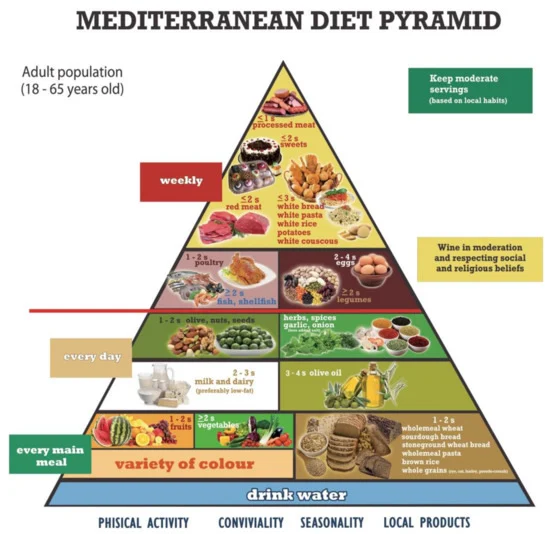
Nutrition: The Basics – Why every meal should be about balance
All food is made up of a base of three main macronutrients: carbohydrate, protein and fat. Despite all three being an essential part of the diet, some of these have been demonised over the years, largely prompted by the search for “the best diet”. But is there such a thing?
In the 1960’s eating a low-fat diet became the craze, with the belief that eating fat made you fat. But fortunately, it doesn’t work like that! Then on the opposite end came along the ketogenic and Atkins diets. Both of which are high in fat and low in carbohydrates, and Atkins with an added focus on protein. Whilst such diets have shown successful weight loss initially, a particular study found that none of the fourteen popular diets included led to maintained weight loss after 12 months [1]. This suggests that there may not be an optimal macronutrient ratio, especially when it comes to weight loss.
One thing that is certain is our body’s need for all three macronutrients. They are required in relatively large quantities daily to support vital functions such as cellular growth and repair, immune function and as a source of energy. Hence, cutting out or heavily restricting a whole food group can hinder your body from functioning optimally.
So what is the best balanced diet?
Despite many diets failing to show long-term success, there is one diet which has stood the test of time: the Mediterranean diet. This diet is less about restriction and more about quality. The Mediterranean diet has a particular focus on certain fats, including olive oil and fatty fish, alongside fruits, vegetables and wholegrains. To the surprise of some, even the odd glass of red wine is included too. Its widely accepted inclusion is likely due to the antioxidant-rich polyphenols found in red wine. Though, this isn’t to say drinking a bottle of red wine is healthy! The benefits, particularly on reduction of cardiovascular disease risk, appear to be limited to a low to moderate consumption (roughly 125ml daily) [2].
Moving back to macronutrients, the typical ratios of the Mediterranean diet have been found to be 50-60% carbohydrates, 15-20% protein and 30% fats, which is considered a fairly balanced split. However, as mentioned, there is the added focus on quality. Whilst this doesn’t contribute to the balance of the plate, the type of carbohydrates and fats consumed in particular are important to obtain the array of health benefits attributed to the Mediterranean diet, such as reduced risk of cardiovascular disease, diabetes, certain cancers and brain function [3].
Choosing better quality also often helps increase the micronutrient content, too. We haven’t mentioned these here (they deserve a whole post of their own!), but these include all the vitamins and minerals that are also essential for optimal health.
The three macronutrients to include in every meal
Ideally you want to build each meal with all three macronutrients. So, what actually are they?
Carbohydrates: These are sugars which vary in length and are primarily used as a fuel source,
providing 4 kcal/g. Carbohydrates are the primary energy source because they are easier to break down and process for producing energy compared to protein and fats. Carbohydrates are split into two groups: simple and complex.
Simple carbohydrates are made up of one or two sugar units, known as mono- and di-saccharides, and due to their short-chain they can be broken down quickly, hence can increase blood sugar quickly. This can be useful in certain situations where you need a rush of energy, such as before intense exercise, but generally it’s best to have a slow and controlled blood sugar increase to avoid the sharp increase followed by the drop, often referred to as a sugar crash! So, limiting simple carbohydrates is usually best. One caveat to add is that fructose, which is naturally present in fruit, is also considered a simple carbohydrate, but when eaten as the whole fruit (ie. not juice) the fibre that is also present slows down the blood sugar increase.
Whereas complex carbohydrates are the longer chain sugars known as polysaccharides. The longer the chain, the more bonds that need to be broken down to form the most common single sugar unit needed for energy production, glucose. Although the final product of this breakdown is the same as with simple carbohydrates, the longer time taken to be released into the blood stream means that the energy release is more controlled and the sugar rush is avoided. This is important for maintaining glucose tolerance by ensuring efficient glucose uptake by cells, therefore reducing the risk of type 2 diabetes [4].
Another type of complex carbohydrate which is not used for energy but supports this controlled sugar release is fibre. The two types of fibre, soluble and insoluble, have a particular benefit for gut health and recent research has found several benefits of consuming at least 30g of fibre daily [5].
Protein: This word might make some think of gym fanatics and body builders, but protein is
essential for every human being. Proteins are chains made up of various combinations of different amino acids. These amino acids are used in the body as a structural component of every cell, from muscle and brain cells to skin, hair and nails. Hence protein is vital for growth and repair, though can also be used as an energy source, usually only when no glucose is available, providing 4 kcal/g.
There are about 20 different amino acids required to make the thousands of different proteins needed by the body, 9 of which are considered essential and can only be obtained by the diet while the others can be formed in the body from these 9. Different foods contain different combinations of amino acids, although typically only proteins from animal sources are “complete” proteins containing all the essential amino acids. However, a plant-based diet can still provide these essential amino acids ensuring that a variety of vegetables, nuts, seeds, wholegrains and legumes are consumed.
Fats: Despite their stigma in the weight loss realm, the fatty acids that form the fats we consume have several vital functions in the body. These include being a key structural component of cells, a carrier of the fat-soluble vitamins A, D, E and K to support their absorption and as a source of energy providing 9 kcal/g.
Not all fats are the same though. The main distinction is between saturated and unsaturated fats. Saturated fats are typically solid at room temperature, while unsaturated fats are typically liquid. Unsaturated fats with just one double bond are known as monounsaturated fatty acids (MUFA), while those with two or more are called polyunsaturated fatty acids (PUFA).
Saturated fats are suggested to increase “bad” LDL cholesterol and the NHS recommends limiting intake of these fats to 10% of daily energy intake [6]. Meanwhile, MUFAs and PUFAs may reduce LDL cholesterol and increase the “good” HDL cholesterol [6]. Hence, replacing saturated fats with unsaturated ones is generally considered healthier and may help to improve cholesterol levels, reducing the risk of cardiovascular disease [7].
There are a particular kind of PUFAs which are considered essential in the diet as they cannot be formed in the body. These are the alpha-linolenic (omega-3) and linoleic (omega-6) fatty acids. Although both are required in the diet, getting the balance between these two appears to be important. The modern western diet has become out of balance with an abundance of omega-6 sources, in foods such as vegetable oils and nuts, but a lack of omega-3 fats, which are most highly sourced in fatty fish. A high omega-6 to omega-3 ratio may have an inflammatory effect on the body, increasing the risk of disease [8], hence it is recommended to consume at least two portions of fatty fish each week [6].
How to build a balanced plate
Now you know what the three macronutrients are, let’s look at the foods you’ll find them in…
Carbohydrates:
- Simple: table sugar, juices, syrups, milk (contains the sugar lactose), processed food and drink (eg. confectionary and fizzy drinks) – remember, these are the ones to limit!
- Complex: oats, legumes (lentils, chickpeas, beans), quinoa, barley, rye, wholegrain bread & pasta, starchy vegetables (potatoes, pumpkin, squash)
Protein:
- Meat, poultry, fish, shellfish, eggs, dairy foods, nuts, seeds, tofu, legumes, protein powder (preferably unsweetened)
Fats:
- Saturated: butter, cheese, meat – again, don’t forget these are the ones to limit!
- Monounsaturated: olive oil, nuts, avocado, olives, vegetable oils
- Polyunsaturated: walnuts, sunflower seeds, flaxseed, fatty fish (eg. salmon, mackerel, herring), soybean oil, flax oil
The dietary pyramid below gives a good visual of what fitting these macronutrients into a varied and balanced Mediterranean-style diet might look like across the day and week [9].

So, the bottom line, eat like you’re living by the Med! Olive oil and red wine (in moderation) may be your best friend when it comes to the “best diet”. Though ultimately, it’s a healthy diet that you can stick to and, perhaps more importantly, enjoy too. But at the very least, ensure each meal contains a source of complex carbohydrates, protein and healthy fats to create a nutritious balanced plate to support your health.
References:
1. Ge, L., Sadeghirad, B., Ball, G., da Costa, B. R., Hitchcock, C. L., Svendrovski, A., Kiflen, R., Quadri, K., Kwon, H. Y., Karamouzian, M., Adams-Webber, T., Ahmed, W., Damanhoury, S., Zeraatkar, D., Nikolakopoulou, A., Tsuyuki, R. T., Tian, J., Yang, K., Guyatt, G. H., & Johnston, B. C. (2020). Comparison of dietary macronutrient patterns of 14 popular named dietary programmes for weight and cardiovascular risk factor reduction in adults: systematic review and network meta-analysis of randomised trials. BMJ (Clinical research ed.), 369, m696. https://doi.org/10.1136/bmj.m696
2. Castaldo, L., Narváez, A., Izzo, L., Graziani, G., Gaspari, A., Minno, G. D., & Ritieni, A. (2019). Red Wine Consumption and Cardiovascular Health. Molecules (Basel, Switzerland), 24(19), 3626. https://doi.org/10.3390/molecules24193626
3. Sánchez-Sánchez, M. L., García-Vigara, A., Hidalgo-Mora, J. J., García-Pérez, M. Á., Tarín, J., & Cano, A. (2020). Mediterranean diet and health: A systematic review of epidemiological studies and intervention trials. Maturitas, 136, 25–37. https://doi.org/10.1016/j.maturitas.2020.03.008
4. Hu, Y., Ding, M., Sampson, L., Willett, W., Manson, J., & Wang, M. et al. (2020). Intake of whole grain foods and risk of type 2 diabetes: results from three prospective cohort studies. BMJ, m2206. doi: 10.1136/bmj.m2206
5. Cobiac, L. J., Scarborough, P., Kaur, A., & Rayner, M. (2016). The Eatwell Guide: Modelling the Health Implications of Incorporating New Sugar and Fibre Guidelines. PloS one, 11(12), e0167859. https://doi.org/10.1371/journal.pone.0167859
6. https://www.nhs.uk/live-well/eat-well/different-fats-nutrition/
7. Clifton, P., & Keogh, J. (2017). A systematic review of the effect of dietary saturated and polyunsaturated fat on heart disease. Nutrition, Metabolism And Cardiovascular Diseases, 27(12), 1060-1080. doi: 10.1016/j.numecd.2017.10.010
8. Simopoulos A. P. (2016). An Increase in the Omega-6/Omega-3 Fatty Acid Ratio Increases the Risk for Obesity. Nutrients, 8(3), 128. https://doi.org/10.3390/nu8030128
9. D’Alessandro, A., Lampignano, L., & De Pergola, G. (2019). Mediterranean Diet Pyramid: A Proposal for Italian People. A Systematic Review of Prospective Studies to Derive Serving Sizes. Nutrients, 11(6), 1296. https://doi.org/10.3390/nu11061296



